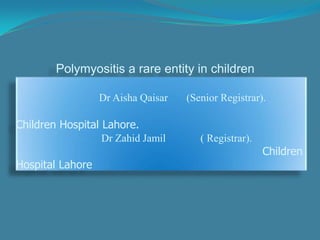
10 year old child presented with body weakness,dysphagia new
- 1. Polymyositis a rare entity in children Dr Aisha Qaisar (Senior Registrar). Children Hospital Lahore. Dr Zahid Jamil ( Registrar). Children Hospital Lahore
- 2. 10 Year old Boy presented with Muscles weakness, Dysphagia and Tip toe walk
- 3. History Name Usman Age 10 Year Resident Okara DOA 17-10-12 MOA OPD
- 4. Presenting Complain weakness 25days Walk on tip of toe 07 Days Dysphagia 02 days Speech Nasal in quality 01 day
- 5. HOPC Progressive weakness difficulty in performing every day work. Getting up from bed Climbing stairs Unable to change his cloth Difficulty in keeping his head up (Head drop) He had difficulty in walking(Unsteady). Tip toe walk 7 days After admission during stay in ward dysphagia. Initially to liquid than s0lid Nasal twang voice
- 6. Cont……. No history of; Cutaneous lesion , o Rash over face , hands neck or shoulder. Heat or cold intolerance constipation ,diarrhea. Photosensitivity, oral ulcer, hair loss. Rhaynaud’s phenomenon Any drug intake
- 7. Cont… He is developmentally normal child Grade 4 doing good at education Consanguineous marriage twin brother. No family h/o myopathy Vaccinated no h/o TB contact Poor socioeconomic class
- 8. Examination General physical examination Conscious ,Oriented, cooperative, but miserable look and lying in agony in bed. Ht 150cm. Wt 30 kg. Temp 98F. BP 180/80. • Generalized edema and muscle tenderness. • No rash over body. • No joint inflammation, deformity. • No calf muscle hypertrophy • No skin tightening or telangectasia
- 9. Central Nervous system Gcs 15/15 Tone normal Power 3/5 in both upper and lower Proximal muscle weakness limb at hip and shoulder joint fine movements of hand were intact Reflexes were elicit able Sensation was intact cranial nerve also intact No ocular facial or respiratory muscle weakness were noted at time of admission. Gower sign +ve He was walking on tip of his toes. GIT………………..normal CVS………………..normal Respiration ……normal
- 10. D/D Based on these finding following diagnosis we initially considered. A. Acute Viral myositis B. Polymyositis C. dermyomyositis
- 11. Proximal muscle weakness in the absence of cutaneous lesion is suggestive of Polymyositis.
- 12. Investigation CBC ESR……..45 • Hb………10 CRP………10 • TLC……..11OOO • N………….63% • L……………21% CPK………….2036 • Plt…………543 LDH............1613 ANA -VE RAF -VE ECG Normal NCS Normal CXR Normal
- 13. EMG
- 14. Muscle biopsy
- 15. Inflammatory myopathy Group of disorder characterized by; Proximal muscle weakness Non suppurative inflammation of skeletal muscle with predominantly lymphocytic infiltrate
- 16. Inflammatory myopathy Clinical Classification Dermatomyositis Polymyositis Inclusion Body myositis
- 17. Epidemiology Rare disease in children Usualy seen after 18 yrs Incidence in USA is .5 to 8.4/million population. More common in female
- 18. Cause Autoimmune in origin
- 19. T cell mediated Asso: other myocytotoxity autoimmune dis: Comliment Auto antibodies mediated microangiopathy Response to Histocompatibility genes immunosuppressive therpy Supported by
- 20. T cell mediated cytotoxicty Viral Malignancies C.T Disorders
- 21. Pathophysiology Cytotoxic Cd8+T Invade muscle tissue Damaging Vescular endothelium Virus Muscle destruction CK Abnormal expression MCHC
- 22. Auto antibodies dectected in 60-80% Types: Myositis associated Ab Myositis Specific Antibody
- 23. Myositis associated Autoantibodies: • Shared with other autoimmune dis: • Found in 20-50% of Patients
- 24. Myositis Specific antibodies • Unique to myositis. • Found in 40% of cases. • Three main types: Anti -jo -1 Ab Anti - Mi-2 Anti-SRP
- 25. ILD Arthritis Acute onset Fever Good Prognosis Good Response to Therpy. Cardiac Involvewment PoorPrognosis Poor response to therapy
- 26. Ocular And Facial Muscles never Involved Dysphagia and dysphonia may occur Neck muscles are involved in 50 % of cases Shoulder and Pelvic muscles Most severly affected Distal muscles are spared In majority and early in the course Usually insidious in onset Toe walking No identified precipitant Skin Rash always absent
- 27. Arthritis arthlalgia Dysphagia Nasal regurgitation Reflux oesophagitis SLE Sarcoidosis Sjogren Abdominal Bloating Odynophagia Constipation
- 28. Myocarditis Tachyarrythmias Interstitial Pneumonitis Ariovent conduction defect Interstitial fibrosis
- 29. Dignosis. Muscles enzymes EMG Muscles biobsy Antibodies dectection Imiging studies Complete bld count
- 30. CK inc; up to 50 times ALT AST Aldolase LDH
- 31. Imaging studies MRI USG To Localize the extent of muscle involvement.
- 32. CBC Leucocytosis or thrombocytosis >50% ESR increased CRP Increase in >50%
- 33. Shared features Both Inflamatory Myopathies Distinct Develop over Features Wks to months. Response to Steriod Demographic Dermatomyositis Features. vs Peculiar Dematological Polymyosits finding. Muscle biopsy features. Calcinosis
- 35. ACR Ctitaria for PM/DM (Bohan & Peter (1975) NEJM) Diagnostic Critaria. 1. Proximal muscle weakness 2. Elevated serum CK 3. Myopathic changes on EMG 4. Muscle biopsy demonstrating Lymphocytic infiltration 5. Typical skin rash of Dermatomyositis eg Gottron, Shawl,Helitrop
- 36. ACR Ctitaria for PM/DM (Bohan & Peter (1975) NEJM) • Using these criteria, polymyositis is defined as Definite All of criteria 1-4 Probable Any three of criteria 1-4 Possible Any two of criteria 1-4 • Dermatomyositis defined as definite 5 plus any three of criteria 1-4 Probable 5 plus any two of criteria 1-4 Possible 5 plus any one of criteria 1-4
- 37. Exclusion criteria for PM/DM Evidence of any central or peripheral neurologic disease Muscle weakness with slowly progressive course, and family history of calf enlargement to suggest muscular dystrophy Biopsy with granulomatous myositis, such as with sarcoidosis Evidence of active infection Recent use of drugs known to be toxic to muscles cocaine, statins, fibrates, etc. Overt rhabdomyolysis Glycogen storage disorders (i.e. McArdle’s) Endocrinopathies hypo-/hyper- thyroid/parathyroid, diabetes, Cushing’s Myasthenia Gravis
- 38. Treatement • Prednisone • 1mg /kg/day 4to 6 weeks Tapering 5 to 10 mg monthly Improve in muscle strength Decrease CK level
- 39. Cont….. • Immunosupperesive • If do not improve • Steroid side effect • Poor prognostic factor Methotrexate IVIG Rituximab
- 40. Cont… • High Protien Diet • Activity and Exercise should be encouraged
